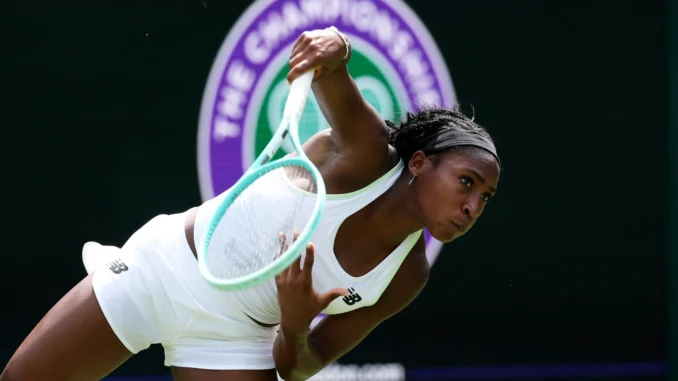
The 2025 Wimbledon Championships delivered a seismic shock on Day 2 as Coco Gauff, the No. 2 seed and reigning French Open champion, suffered a stunning first-round defeat to Ukraine’s Dayana Yastremska. The 7-6(3), 6-1 loss on Court No. 1 under the closed roof marked Gauff’s second first-round exit at Wimbledon in three years, halting her quest for a first title at the All England Club. The 21-year-old American, visibly emotional in her post-match press conference, candidly reflected on her struggles, crediting Yastremska’s brilliance while outlining a clear plan to conquer the grass courts in 2026. Gauff’s resolve to adapt and evolve promises a fierce comeback, underscoring her determination to crack the Wimbledon puzzle that has eluded her since her breakout run in 2019.
Gauff entered Wimbledon as a favorite, fresh off her French Open triumph just weeks earlier, where she claimed her second Grand Slam title. Her 2024 season had been a career-defining one, with victories at the US Open, WTA Finals, and United Cup, solidifying her as world No. 2. Yet, the transition from the red clay of Roland Garros to the slick grass of Wimbledon proved daunting. “I felt like mentally I was a little bit overwhelmed with everything that came afterwards,” Gauff admitted, her eyes welling with tears. The whirlwind of media duties, including appearances on major U.S. talk shows, left her with little time to celebrate her Paris victory or prepare for the grass season. A first-round loss in Berlin to Wang Xinyu further limited her grass-court practice, leaving her vulnerable against Yastremska’s aggressive play.
The match itself was a masterclass in Yastremska’s fearless tennis. The world No. 42, who reached the 2024 Australian Open semifinals and the Nottingham final earlier in 2025, unleashed 16 winners to Gauff’s six, exploiting the American’s shaky serve. Gauff’s nine double faults, including two in the critical first-set tiebreak, and 29 unforced errors underscored her discomfort on the low-bouncing grass. “Dayana played great,” Gauff acknowledged, giving credit to her opponent’s blistering groundstrokes and sure-footed movement. “I was really on fire,” Yastremska said, flashing her fiery nail art to the crowd. “This court brings me a lot of nice memories,” she added, recalling her 2016 junior final appearance at Wimbledon.
Gauff’s struggles on grass are not new. Despite her iconic 2019 debut, where she stunned Venus Williams at age 15 to reach the fourth round, Wimbledon remains the only major where she has yet to reach the quarterfinals. Her topspin-heavy forehand, a weapon on clay and hard courts, struggles with the low bounces of grass, particularly against aggressive players like Yastremska who rush her timing. “I just feel like the surface I maybe could have used more matches,” Gauff said, pinpointing her lack of grass-court preparation as a key factor. She contrasted this with the easier transition from clay to hard courts, noting, “I think it’s just changing my playing style a little bit, which is difficult.”
Looking ahead to 2026, Gauff has already formulated a strategy to avoid repeating this year’s missteps. “It’s the first time in this experience of coming off a win and having to play Wimbledon, and I definitely learned a lot of what I would and would not do again,” she said. She plans to prioritize additional grass-court tournaments, such as Bad Homburg or Eastbourne, to build confidence and rhythm before Wimbledon. “I have faith that if I can make these adjustments, I can do well here,” she emphasized, refusing to write herself off on grass despite her 65% win rate on the surface, lower than her 70% on other surfaces. Gauff’s commitment to adapting her game—potentially incorporating more aggressive shot-making and refining her serve—signals a proactive approach to mastering Wimbledon’s unique demands.
The defeat, while painful, is not without a silver lining. Gauff’s previous first-round Wimbledon loss in 2023 preceded her US Open title, suggesting she can rebound from setbacks. “I’m not going to dwell on this too long because I want to do well at the US Open,” she said, already eyeing her home Grand Slam at Flushing Meadows. With ample time to regroup and train on hard courts, Gauff’s resilience and youth—she’s still only 21—position her well for a strong showing. Her collaboration with coach Matt Daly, who helped retool her serve after her 2024 US Open exit, will likely play a key role in her preparation.
Yastremska, meanwhile, basked in the glow of her victory, signing autographs and taking selfies with fans. “Playing against Coco, it is something special. She’s a great player, great person,” she said, noting their good relationship off the court. Her performance, backed by recent grass-court success, sets her up for a second-round clash with qualifier Anastasia Zakharova, with potential to make a deeper run.
Gauff’s early exit was part of a chaotic opening round at Wimbledon 2025, with top seeds like Jessica Pegula, Alexander Zverev, and Qinwen Zheng also falling. Yet, Gauff’s philosophical outlook offers hope. “I don’t really like losing,” she admitted, her voice cracking. “I just feel a little bit disappointed in how I showed up today.” But her determination to learn from this loss and her unwavering belief in her potential—“I really do want to do well here”—ensure that her Wimbledon story is far from over. As she prepares for 2026, Gauff’s focus on process over results will guide her quest to conquer the grass courts and add a Wimbledon title to her growing legacy.
Leave a Reply